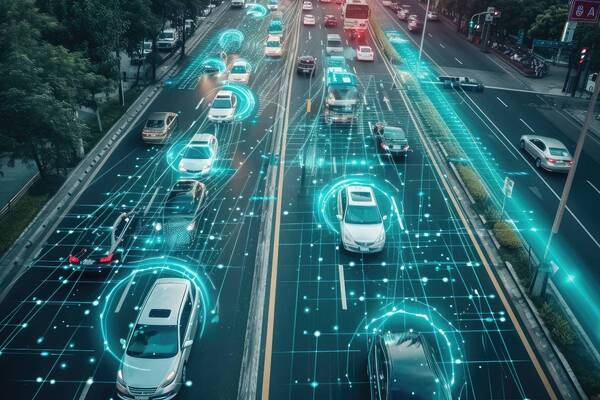Intelligent Transportation Systems
Intelligent Transportation Systems (ITS) bring together advanced technologies to make transportation smarter, safer, and more efficient. Leveraging real-time data, connectivity, and automation, ITS improves how people and goods move through urban and rural areas. By integrating technologies like sensors, vehicle connectivity, and data analytics, ITS can detect driving risks, optimize traffic flows, and support safer maneuvering in real-time, all while making transport systems more responsive and efficient.
A significant focus within ITS is managing driving risk. Through vehicle-to-vehicle (V2V) and vehicle-to-infrastructure (V2I) communication, ITS allows vehicles to share information about their speed, position, and road conditions with other cars and nearby infrastructure. This enables real-time alerts for drivers about potential hazards, unexpected maneuvers by other vehicles, or sudden changes in road conditions. Such connectivity reduces reaction time and lowers the likelihood of accidents, especially in high-traffic or high-speed situations, creating a safer experience for all road users.
ITS also plays a pivotal role in detecting driving maneuvers and providing insights into vehicle behavior. For instance, advanced driving assist systems (ADAS) analyze and monitor lane changes, braking patterns, and sudden accelerations, providing feedback that can improve driver performance and alerting fleet managers or transportation centers to any abnormal or potentially dangerous behaviors. This aspect of ITS is crucial for fleet management, where real-time data on vehicle performance, driver behavior, and route optimization is essential for improving both safety and efficiency.
Connected car technology is another transformative element of ITS. Through an ecosystem of sensors and communication modules, connected vehicles can maintain constant awareness of nearby vehicles, pedestrians, traffic lights, and other infrastructure, contributing to smoother traffic flows and fewer delays. For example, connected cars can adjust their speed or route to avoid congested areas or reroute based on live traffic data from ITS networks. This connectivity not only improves individual driving experiences but also allows cities to better manage traffic flow and respond to congestion or incidents more effectively.
Fleet management is another key application within ITS. Using data-driven insights from ITS, fleet managers can track and monitor vehicles across extensive geographic areas, optimizing routes, managing fuel consumption, and ensuring timely maintenance for long-term reliability. Advanced fleet management systems also enable tracking of driver behavior and adherence to safety protocols, reducing the risks associated with long-distance and high-frequency transportation operations. The ability to optimize fleet logistics and provide safety feedback ultimately reduces costs and improves reliability, essential for commercial and public transport systems alike.
ITS also supports sustainability by reducing fuel consumption and emissions. Through coordinated traffic signal systems, efficient routing, and adaptive cruise control, vehicles can avoid unnecessary idling and optimize fuel use. Eco-driving assist systems and intelligent route planning further enhance fuel efficiency, helping reduce the environmental impact of transportation.
As ITS evolves, the focus on technologies such as artificial intelligence, edge computing, and autonomous driving will further expand its capabilities. Autonomous vehicles, for instance, will rely heavily on ITS infrastructure to navigate safely, interact with other vehicles, and respond dynamically to traffic conditions. Future ITS solutions promise even more integration, with seamless interaction between private vehicles, public transit, and shared mobility solutions like e-scooters and bike-sharing systems.
In summary, intelligent transportation systems represent a forward-thinking approach to transportation, one that emphasizes safety, efficiency, and sustainability. By merging real-time connectivity with advanced analytics, ITS provides a powerful infrastructure for reducing driving risks, supporting safer maneuvers, managing connected fleets, and optimizing traffic flow. As these systems continue to develop, ITS will play an increasingly crucial role in making transportation smarter and more responsive to the challenges of modern mobility.
A significant focus within ITS is managing driving risk. Through vehicle-to-vehicle (V2V) and vehicle-to-infrastructure (V2I) communication, ITS allows vehicles to share information about their speed, position, and road conditions with other cars and nearby infrastructure. This enables real-time alerts for drivers about potential hazards, unexpected maneuvers by other vehicles, or sudden changes in road conditions. Such connectivity reduces reaction time and lowers the likelihood of accidents, especially in high-traffic or high-speed situations, creating a safer experience for all road users.
ITS also plays a pivotal role in detecting driving maneuvers and providing insights into vehicle behavior. For instance, advanced driving assist systems (ADAS) analyze and monitor lane changes, braking patterns, and sudden accelerations, providing feedback that can improve driver performance and alerting fleet managers or transportation centers to any abnormal or potentially dangerous behaviors. This aspect of ITS is crucial for fleet management, where real-time data on vehicle performance, driver behavior, and route optimization is essential for improving both safety and efficiency.
Connected car technology is another transformative element of ITS. Through an ecosystem of sensors and communication modules, connected vehicles can maintain constant awareness of nearby vehicles, pedestrians, traffic lights, and other infrastructure, contributing to smoother traffic flows and fewer delays. For example, connected cars can adjust their speed or route to avoid congested areas or reroute based on live traffic data from ITS networks. This connectivity not only improves individual driving experiences but also allows cities to better manage traffic flow and respond to congestion or incidents more effectively.
Fleet management is another key application within ITS. Using data-driven insights from ITS, fleet managers can track and monitor vehicles across extensive geographic areas, optimizing routes, managing fuel consumption, and ensuring timely maintenance for long-term reliability. Advanced fleet management systems also enable tracking of driver behavior and adherence to safety protocols, reducing the risks associated with long-distance and high-frequency transportation operations. The ability to optimize fleet logistics and provide safety feedback ultimately reduces costs and improves reliability, essential for commercial and public transport systems alike.
ITS also supports sustainability by reducing fuel consumption and emissions. Through coordinated traffic signal systems, efficient routing, and adaptive cruise control, vehicles can avoid unnecessary idling and optimize fuel use. Eco-driving assist systems and intelligent route planning further enhance fuel efficiency, helping reduce the environmental impact of transportation.
As ITS evolves, the focus on technologies such as artificial intelligence, edge computing, and autonomous driving will further expand its capabilities. Autonomous vehicles, for instance, will rely heavily on ITS infrastructure to navigate safely, interact with other vehicles, and respond dynamically to traffic conditions. Future ITS solutions promise even more integration, with seamless interaction between private vehicles, public transit, and shared mobility solutions like e-scooters and bike-sharing systems.
In summary, intelligent transportation systems represent a forward-thinking approach to transportation, one that emphasizes safety, efficiency, and sustainability. By merging real-time connectivity with advanced analytics, ITS provides a powerful infrastructure for reducing driving risks, supporting safer maneuvers, managing connected fleets, and optimizing traffic flow. As these systems continue to develop, ITS will play an increasingly crucial role in making transportation smarter and more responsive to the challenges of modern mobility.




